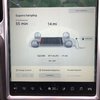As of now I would not buy another Tesla, period. I just don't trust Tesla any more.
Even though our P85D has not been capped, my husband mentioned the possibility yesterday of selling it now and buying a non-Tesla for the exact same reasons. He feels like his car could be capped any day, and is very untrusting of Tesla to do the right thing, so he was contemplating selling while the car was still “good”.
The only downside for selling now is he would be going back to an ICE since the other EV options out there today do not appeal to him (he is not a crossover fan). It is too bad more manufacturers haven’t stepped up to the EV plate yet.



